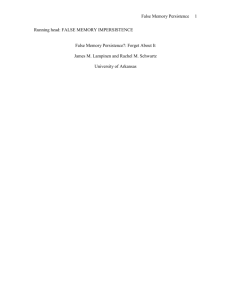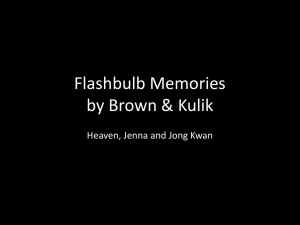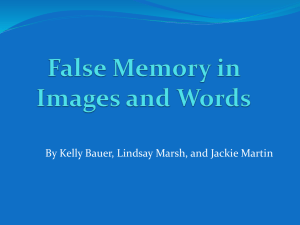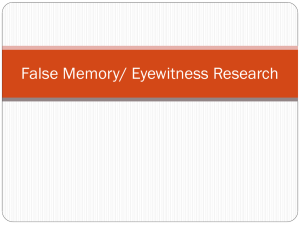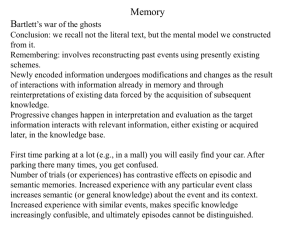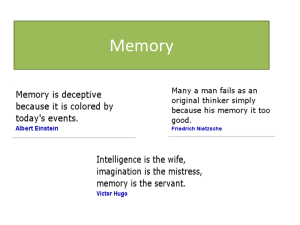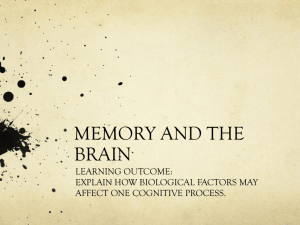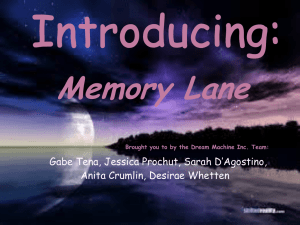Content/Borrow Model - University of Arkansas
advertisement
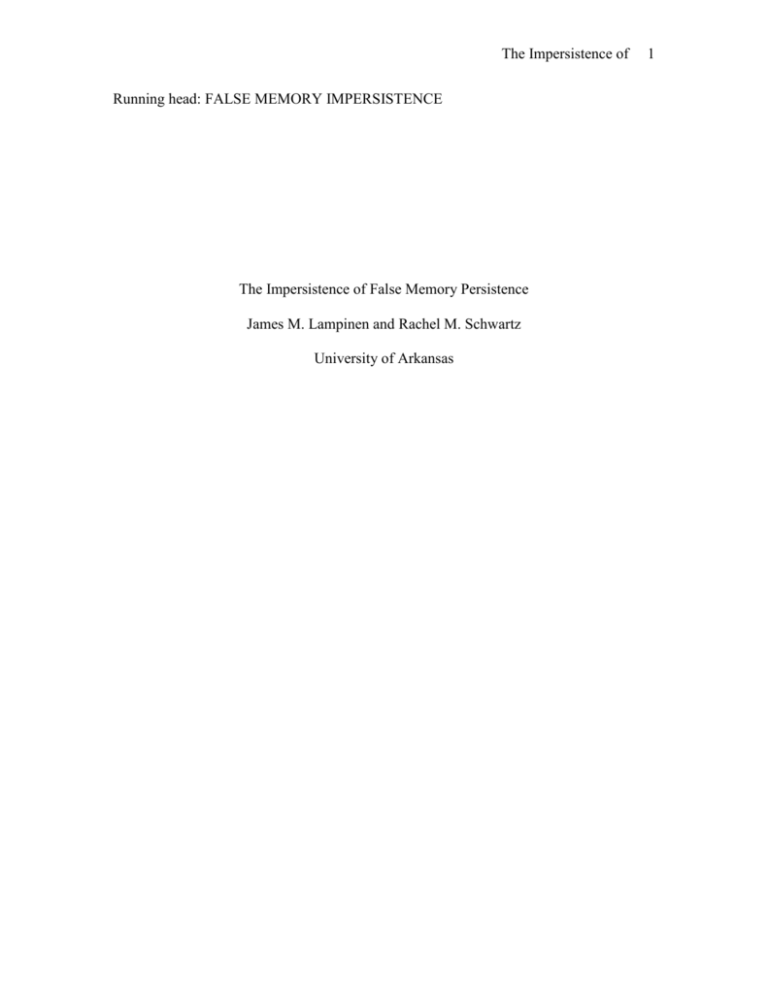
The Impersistence of Running head: FALSE MEMORY IMPERSISTENCE The Impersistence of False Memory Persistence James M. Lampinen and Rachel M. Schwartz University of Arkansas 1 The Impersistence of 2 Abstract When subjects study lists of thematically related words they sometimes falsely recognize non-presented words related to the theme. The gist extraction account of these findings provided by Fuzzy Trace Theory suggests that false recognition should decline substantially more slowly than true recognition across a delay. Participants listened to six lists of words with each being related to a non-presented critical lure. Participants then took a recognition memory test immediately or after a 48-hour delay. Contrary to Fuzzy Trace Theory corrected recognition of targets and critical lures decreased by equivalent amounts across the 48-hour delay. Results are discussed in terms of their implications for Fuzzy Trace and Source Monitoring accounts of false memories. The Impersistence of 3 The Impersistence of False Memory Persistence A false memory is a memory for an event that never occurred and therefore involves the creation of a psychological reality that is distinct from historical reality. Recently, Roediger and McDermott (1995) have revived a paradigm introduced by Deese (1959) that can be used to create compelling false memories for words (hereafter the DRM paradigm). Subjects are presented with lists of words (e.g. bed, slumber, doze and so on) that are all related to a non-presented critical lure (e.g. sleep). On later tests subjects claim to remember the critical lure as having been presented with surprisingly high levels of subjective confidence (Lampinen, Neuschatz & Payne, 1998; Payne, Neuschatz, Lampinen & Lynn, 1997 for reviews). One account of these results is the gist extraction account of Fuzzy Trace Theory (Reyna & Brainerd, 1995). Fuzzy Trace Theory's core assumption is that in a wide variety of tasks people tend to encode multiple representations in parallel and that these representations vary in terms of their level of precision. Memory traces that represent item level information including surface features of items are verbatim representations. Memory traces that represent general senses and meanings including relational information are gist traces. An important assumption of the theory is that false recognition in many paradigms (including the DRM paradigm) is produced when subjects base their recognition memory judgment on gist representations (Brainerd, Reyna & Mojardin, 1999). The theory also assumes that verbatim traces decay more rapidly than gist traces (Brainerd, Reyna, & Brandse, 1995). Combining these assumptions leads to the The Impersistence of 4 prediction that false memories will be forgotten more slowly than true memories (i.e. the false memory persistence effect). Payne, Elie, Blackwell, and Neuschatz (1996) provided evidence that false recognition produced in the DRM paradigm sometimes does decline more slowly than accurate recognition. Payne et al. presented subjects with lists of thematically related words. After each list each subject sometimes attempted to recall the list and sometimes did math problems before the next list was presented. Shortly after the final list was presented or 24 hours after the final list was presented subjects took a recognition test. Consistent with the gist extraction account there was a substantial decrease in recognition of presented items across the delay but no significant decrease in the recognition of critical lures. An alternative account of false memories in the DRM paradigm focuses on the possibility that the critical lure might sometimes be spontaneously generated by subjects as an implicit associative response (IAR) while processing list items at acquisition (Underwood, 1965). This account has been called the "source monitoring" account by McDermott and Roediger (1998) and is based on the well established finding that internally generated information is sometimes confused with externally presented information (Johnson, 1997). It is important to note that Brainerd, et al. (1999) have recently argued that if false memories were created in this manner they would be verbatim based but they have also argued that current evidence does not support the existence of such verbatim false memories. It is important to note that Fuzzy Trace Theory's prediction of false memory persistence is contingent upon false memories being produced by gist traces. For The Impersistence of 5 instance, Brainerd, et al. (1995, Experiment 3) found that false alarms that sounded like targets did not produce the false memory persistence effect whereas false alarms that were semantically related to targets did (Experiments 1 and 2). If false memories in the DRM paradigm are sometimes verbatim based then it should be possible to establish circumstances in which forgetting of false memories is equivalent to forgetting of true memories. Payne et al. (1996) used a relatively fast presentation rate (one word per second) and subjects were aware that after every list there was a good chance that they would have to immediately recall that list. These two factors together may have favored gist extraction over the spontaneous generation of the critical lure. It may be difficult to explicitly generate the critical lure at a very fast presentation rate and knowledge that an immediate recall test had a good chance of following each list may have caused subjects to engage in organizational strategies that favored gist extraction. In Payne et al.'s study it is also noteworthy that for lists that were followed by math problems there did appear to be some decrease in recognition of critical lures across the 24 hour delay. It may be that the significant item type by delay interaction they found was driven primarily by the condition in which subjects attempted to recall items after the presentation of the list. It is our aim to determine if, under some circumstances, recognition of critical lures will decline at similar rates to recognition of targets across a delay. If this occurs it could be interpreted as evidence either that gist based recognition and verbatim based recognition sometimes decline at similar rates or that not all false memories in the DRM paradigm are gist based. Because differential forgetting of gist and verbatim is an important assumption of Fuzzy Trace Theory, a reasonable tentative hypothesis might be The Impersistence of 6 that such results would support the existence of verbatim false memories in the DRM paradigm and lend credence to the source monitoring account. In the present experiments we examined the effects of a 48 hour delay on recognition of presented items and non-presented critical lures using a slower presentation rate than that used by Payne et al. (1996) and without asking subjects to perform interpolated recall/math tests after each list. In both experiments corrected recognition of targets and critical lures declined at similar rates. Method Subjects Eighty-four students participated for partial fulfillment of course requirements for an introductory psychology course. We used a large number of subjects in the initial experiment because we wanted to ensure that their was sufficient statistical power to uncover the item type by delay interaction predicted by Fuzzy Trace Theory if it was there. Materials Study Lists. Twelve of the 15 item lists from Roediger and McDermott (1995) were used. Six lists were presented to subjects and six lists were used to select distractors for the recognition test. Lists were counterbalanced such that each list served equally often as a presented list and as a distractor list. The lists were presented at a rate of two seconds per word on audio-tape. Test List. An old/new recognition test consisting of 48 items was developed. Four types of items were included on the test: targets, critical lures, distractors, and distractor lures. Targets were items that had been presented at acquisition. Three targets The Impersistence of 7 were taken from each of the six studied lists (the first, eighth, and tenth items from each list). The test also included 6 critical lures. These were the non-presented words to which the targets were related. The test also included eighteen distractors and six distractor lures developed in the same manner as the targets and critical lures but taken from lists that were presented to other subjects. Procedure Subjects were randomly assigned to be tested immediately after the acquisition phase of the experiment or after a 48 hour delay. After some initial instructions subjects listened to the word lists. The subjects in the zero minute condition then took the recognition memory test while subjects in the delay condition completed math problems. All subjects were then dismissed and returned 48 hours later. The students who had already taken the recognition test worked on math problems at this time while students in the forty-eight hour delay condition took the recognition memory test. Results According to the gist extraction account recognition of targets should decline much more rapidly than recognition of critical lures over a 48 hour delay. To test this prediction we analyzed uncorrected recognition of targets and critical lures as well as recognition corrected for response bias. To preview, whether we found any evidence for false memory persistence depended critically on whether or not we corrected for response bias. Uncorrected target and critical lure recognition are depicted in Figure 1. Consistent with the false memory persistence prediction uncorrected recognition of targets declined by more (M = 13.4%) than uncorrected recognition of critical lures (M = The Impersistence of 8 5.1%). In absolute terms this difference is on the same order of magnitude as the difference reported in the math condition of Payne et al. (1996). Arguably their math condition is the condition most similar to the procedures used in the present experiment. To test these predictions we conducted a 2 (Item Type: Target, Critical lure) X 2 (Delay: 0 minute, 48 hour) ANOVA. This analysis revealed that significantly fewer items were recognized after the 48 hour delay than after the immediate test, F (1, 82) = 8.37, MSE = .04. Recognition of targets and critical lures did not significantly differ, F < 1. Importantly there was also a marginally significant interaction between item type and delay, F (1, 82) = 3.10, MSE = .02, p = .082. Thus Experiment 1 produced results that were very similar to the results obtained by Payne et al. using uncorrected recognition scores. Although the interaction between item type and delay was not significant at conventional levels, the trend is in the direction of more forgetting of targets than critical lures. These results however do not tell the full story because they fail to account for possible response bias differences between conditions. Although there are several possible ways of correcting for response bias the corrections we used in these experiments are given by the equations: Corrected Target = (Target - Distractor) / (1-Distractor) Corrected CL = (Critical Lure - Distractor Lure) / (1-Distractor Lure) These corrections were used because they assume that the contributions of memory based and response bias based processes to recognition memory judgments are statistically independent. This assumption is one of the assumptions included in the theory of recognition memory recently proposed by Brainerd, et al. (1999) and so it seemed like the The Impersistence of 9 most reasonable correction to use as a test of a prediction arising out of Fuzzy Trace Theory. 1 We applied these corrections to the data from the present experiment to derive corrected recognition scores for targets and critical lures. These corrected recognition scores are displayed in Figure 2. We performed a 2 (Item Type: Target, Critical Lure) X 2 (Delay: Immediate, 48 hour) mixed factorial ANOVA on the corrected recognition scores of targets and critical lures. Results indicated a significant main effect of delay with lower corrected recognition scores when subjects were tested after 48 hours than when subjects were tested immediately after the presentation of the lists, F (1, 82) = 11.84, MSE = 0.07. Corrected recognition of targets and critical lures did not significantly differ, F < 1. Importantly, and contrary to the prediction of the gist extraction account, there was no significant interaction between delay and item type, F<1. General Discussion Recent theoretical accounts of false memories in the DRM paradigm have contrasted two major explanations. One account is the gist extraction account of Fuzzy Trace Theory. Fuzzy Trace Theory is a broad theoretical framework that has been used to explain results in child and adult cognition, in reasoning and in memory, and which has made a number of interesting and sometimes counter-intuitive predictions that have later been confirmed (Reyna & Brainerd, 1995). The other account is the Source Monitoring Account which claims that false memories are produced when subjects spontaneously generate the critical lure as an implicit associative response at time of acquisition and then later become confused about the source of their memory (Underwood, 1965). Fuzzy Trace Theory would treat false memories created in this way The Impersistence of 10 as verbatim false memories with the same forgetting function as other verbatim memories. Interpretation of the present results depends on whether one believes the appropriate way of addressing the false memory persistence question is to rely on corrected or uncorrected recognition scores. If one relies on corrected recognition scores then the present experiment paints a consistent picture of false memory impersistence. Corrected recognition declined by approximately the same amount for targets and critical lures. The most recent version of Fuzzy Trace Theory explicitly acknowledges that response bias contributes to performance on recognition memory tests (Brainerd, et al., 1999) and this suggests that some method must be used to correct for response bias if one is to evaluate claims of false memory persistence. If, however, one relies on uncorrected recognition scores the story becomes somewhat more complex. The trend in the results supported the claim of false memory persistence. Uncorrected false recognition appeared to decline more slowly across the delay than did uncorrected recognition of targets although the interaction was not significant at conventional levels. Thus one interpretation of the present experiments is that they provide evidence for false memory impersistence, at least in corrected recognition. There are at least two possible accounts of false memory impersistence in corrected recognition. One account is that under some circumstances gist based recognition and verbatim based recognition decline at equivalent rates. This interpretation would be somewhat troublesome for Fuzzy Trace Theory because the theory treats slower forgetting of gist as one of the central predictions of the theory. The results also leave open the possibility that false The Impersistence of 11 memories in the DRM paradigm might be verbatim based. The existence of verbatim false memories is not a new concept. Fuzzy Trace Theory acknowledges the existence of verbatim false memories in cases in which experimenters create false memories through suggestions and subjects confuse the suggested information with explicitly presented information (Brainerd & Poole, 1997). An addendum to that proposal might be that verbatim false memories are also sometimes created in the DRM paradigm. It is important to note that it appears that this finding of approximately equivalent forgetting of targets and critical lures is not limited to our laboratory. Recently Neuschatz (1999 Experiment 3) compared recognition of targets and critical lures across a 48 hour delay and failed to find an interaction between item type and delay. Although corrected recognition scores were not reported examination of his means for targets, critical lures, distractors and distractor lures makes it is possible to estimate that corrected recognition of targets declined by 0.28 and corrected recognition of critical lures declined by 0.26 when using Schacter et al.'s (1996) high threshold correction procedure and by 0.21 and 0.18 when using the correction procedure adopted in the present article. This independent finding provides some confirmation that false memories can at times be as impersistent as true memories. None of this is meant to gainsay the importance of gist extraction processes in creating false memories or the importance of Fuzzy Trace Theory's broad account of false memories. There is some evidence consistent with false memory persistence in recall in the DRM paradigm (e.g. Toglia, Neuschatz & Goodwin, 1999). Additionally, the overall pattern of forgetting in Payne, et al. (1996) suggests that there are conditions in which delay affects recognition of targets and critical lures in very different ways. This was The Impersistence of 12 particularly true in their recall condition. It is possible that the differences between our results and their results hinge on both the relatively fast presentation rate they used as well as the fact that subjects were aware that they might have to immediately recall each list. These differences may have caused a greater proportion of gist based false memories in their study than in ours. Another salient difference between our experiments and Payne, et al.'s experiment is that subjects in the delay condition of our experiment performed an interpolated task while subjects in the immediate testing condition were taking their test. All subjects were then dismissed at the same time. This immediate interpolated task may have prevented consolidation of the gist trace. Interestingly Neuschatz (1999) also had subjects in the delayed recognition condition perform an interpolated task before dismissing them. The present results provide some evidence consistent with the claim that two mechanisms are at play in the creation of false memories in the DRM paradigm. On the one hand, evidence from Payne et al. (1996) suggests that subjects sometimes rely on gist traces that lead them to falsely recognize items on recognition tests. On the other hand, evidence from the present study, and from Neuschatz's (1999) study, suggest that at other times true and false memories may be forgotten at an equivalent rate, opening up the possibility that verbatim traces may play a role in the creation of false memories for words not presented in lists. Brainerd and Poole (1997) have suggested that the relative rate of forgetting of true and false memories may be dependent on the relative contribution of verbatim and gist processes to these memories. An important avenue for future research therefore is to The Impersistence of examine systematically the factors that lead to false memory persistence and those that lead to false memory impersistence. 13 The Impersistence of 14 Author Notes 1 It is important to note that the overall pattern of results did not change when we instead used the high threshold correction procedure that has been used by Schacter (Israel & Schacter, 1997; Schacter, Verfaellie & Pradere, 1996) and other false memory researchers (Payne, Lampinen & Cordero, 1996; Seamon, Luo & Gallo, 1998). In this procedure corrected recognition of targets is given by the equation: Corrected Target = Target - Distractor; and corrected recognition of critical lures is given by the equation: Corrected Critical Lure = Critical Lure - Distractor Lure. Thus our results are not an idiosyncratic function of the particular correction procedure we adopted. 2 We'd like to thank the members of the false memory lab at the University of Arkansas for their help with this project (http://comp.uark.edu/~lampinen/lab.html). We'd also like to thank David Payne, Chuck Brainerd and an anonymous reviewer for their helpful comments on earlier versions of this manuscript. The Impersistence of 15 References Brainerd, C.J. & Poole, D.A. (1997). Long-term survival of children's false memories: A review. Learning and Individual Differences, 9, 125-151. Brainerd, C. J. & Reyna, V. F. (1998). Fuzzy-trace theory and children's false memories. Journal of Experimental Child Psychology, 71, 81-129. Brainerd, C. J., Reyna, V. F., & Brandse, E. (1995). Are children’s false memories more persistent than their true memories? Psychological Science, 6, 359-364. Brainerd, C. J., Reyna, V.F., & Mojardin, A. H. (1999) Conjoint recognition. Psychological Review, 106, 160-179. Deese, J. (1959). On the prediction of occurrence of particular verbal intrusions in immediate recall. Journal of Experimental Psychology, 58, 17-22. Israel, L. & Schacter, D.L. (1997). Pictorial encoding reduces false recognition of semantic associates. Psychonomic Bulletin & Review, 4, 577-581. Johnson, M.K. (1997). Identifying the origin of mental experience. In M.S. Myslobodsky (Ed.). The Mythomanias: The Nature of Deception and Self-deception. (pp. 133180). Hillsdale, NJ: Lawrence Erlbaum Associates. Lampinen, J. M., Neuschatz, J. S., & Payne, D. G. (1998). Memory illusions and consciousness: Examining the phenomenology of true and false memories. Current Psychology, 16, 181-223. Lampinen, J. M., Neuschatz, J. S., & Payne, D. G. (1999). Source attributions and false memories: A test of the demand characteristics account. Psychonomic Bulletin & Review, 6, 130-135. The Impersistence of 16 McDermott, K. B. (1996). The persistence of false memories in list recall. Journal of Memory and Language, 35, 212-230. McDermott, K.B. & Roediger, H.L. (1998). Attempting to avoid illusory memories: Robust false recognition of associates persists under conditions of explicit warning and immediate testing. Journal of Memory and Language, 39, 508-520. Neuschatz, J.S. (1999). Assessing the Phenomenological Characteristics of False Memories. Unpublished doctoral dissertation. State University of New York at Binghamton. Binghamton NY. Payne, D. G., Elie, C. J., Blackwell, J. M., & Neuschatz, J. S. (1996). Memory illusions: Recalling, recognizing, and recollecting events that never occurred. Journal of Memory and Language, 35, 261-285. Payne, D.G., Neuschatz, J.S., Lampinen, J.M., & Lynn, S.J. (1997). Compelling memory illusions: The qualitative characteristics of false memories. Current Directions in Psychological Science, 6, 56-60. Reyna, V. F. & Brainerd, C. J. (1995). Fuzzy-trace theory: An interim synthesis. Learning and Individual Differences, 7, 1-75. Roediger, H. L. & McDermott, K B. (1995). Creating false memories: Remembering words not presented in lists. Journal of Experimental Psychology: Learning, Memory and Cognition, 21, 803-814. Schacter, D.L., Verfaellie, M. & Pradere, D. (1996). The neuropsychology of memory illusions: False recall and recognition in amnesiac patients. Journal of Memory and Language, 35, 319-334. The Impersistence of 17 Seamon, J.G., Luo, C.R. & Gallo, D.A. (1998). Creating false memories of words with or without recognition of list items: Evidence for nonconscious processes. Psychological Science, 9, 20-26. Toglia, M.P., Neuschatz, J.S. & Goodwin, K.A. (1999). Recall accuracy and illusory memory: When more is less. Memory, 7, 233-256. Tulving, E. (1985). Memory and consciousness. Canadian Psychologist, 26, 1-12. Underwood, B. J. (1965). False recognition produced by implicit verbal responses. Journal of Experimental Psychology, 70, 122-129. The Impersistence of Figure Captions Figure 1. Uncorrected Recognition Scores for Targets and Critical Lures. Figure 2. Corrected Recognition Scores for Targets and Critical Lures. 18 The Impersistence of 19 0.75 0.7 0.65 Recognition 0.6 0.55 Targets Critical Lures 0.5 0.45 0.4 0.35 0.3 Immediate 48 Hours The Impersistence of 20 0.7 0.65 Corrected Recognition 0.6 0.55 Targets Critical Lures 0.5 0.45 0.4 0.35 0.3 Immediate 48 Hours
